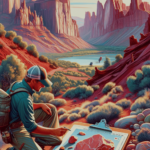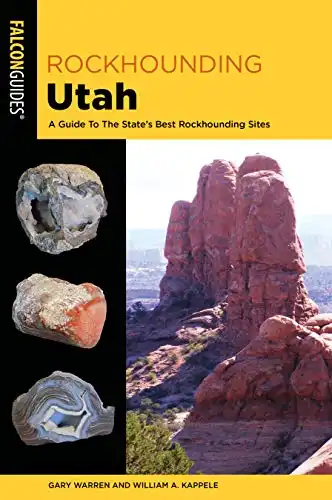Remember! It is your responsibility to know the rockhounding laws and regulations for each site you visit. It is also your responsibility to verify and gain permission to visit each collection site that is mentioned on this website. Always respect private property!
Utah. This state is even known by some as the Rockhounding Capital of the United States.
Destinations throughout
Although rock collecting is permitted on most public lands for personal use, you need to research the area you plan to collect in and be aware of boundaries. Be sure that a permit is not required and check for mining claims. Do not collect on mining claims without the proper permission from the claim owner. Check out some the Rules And Regulations Regarding Rock, Mineral, and Fossil Collecting In
Below you will find detailed information on some of the most popular rocks and fossils collected in
Read More: Where To Find Trilobite Fossils in Utah
- Completely updated and revised
- Full color images
- Each description of the 86 state's sites includes concise information on the material to be found there, the tools to bring, the best season to visit and what type of vehicle to drive.
Utah Rocks And Minerals
Let’s start off by taking a closer look at some of the interesting finds you can discover across the state. From crystals to fossils, this list can only scratch the surface of what
Moqui Marbles
Moqui marbles are a fun and often abundant rock formation found in the spectacular red Navajo Sandstone regions of southern
These formations developed underground when iron minerals seeped through rock layers from flowing groundwater. Over eons, the overlying rock layers eroded and the Navajo Sandstone revealed weather-resistant iron concretions of “marbles”, many of which are amassed in large groups on the surface. They occur in many places in southern
Fossils In Utah
With a little research and some time and effort spent splitting and hammering in the field, fossils can be found in several locations across the state. Before getting too excited though, like most other public lands, only common invertebrate fossils and petrified wood can be legally collected. Dinosaur bones and other fascinating fossils certainly have the chance to be uncovered when rockhounding in
For those interested in collecting fossils in
Dugway Geodes
Like many other forms of geodes, Dugway Geodes formed when hot gasses bubbled up and were trapped within a bubble, leaving beautiful crystal formations. The contents of Dugway geodes vary and at times can be solid quartz, while other times they are hollow with small crystalline formations. These geodes carry the name designation based on the area they’re found.
The Dugway Geode Beds are one of the most popular rock-hounding destinations in
Birdseye Marble
From an ancient lake that covered much of the modern state of
Red Beryl
Red Beryl holds a unique distinction of being one of the rarest gemstones on the earth, and
Red beryl gemstones are generally found in a host rock of rhyolitic lava flow. The rarity of this brilliant gemstone comes from the coincidence of two rare events, leading to it only being found on a select few places on earth. It is thought that the mineral forms once lava has cooled down to form rhyolite. Then rarely found high quantities of beryllium-rich gases move through the cracks in the rhyolite. Lastly, years of descending groundwater carry essential and specific minerals that combine with the beryllium-rich gases to form the the brilliant pink crystals. In
Wonderstone
The beautifully striated wonderstone is a welded-vitric tuff (vitric means glassy) of rhyolitic composition. This volcanic rock forms during explosive eruptions when the molten rock sticks to other materials upon landing. If it is then buried while hot, it take this compacting action to form the mineral into a soft glassy-like welded-tuff material we know as wonderstone.
Wonderstone is generally given it’s characteristic yellow, orange, brown, and red matrixes of colors from the years of staining from dissolved minerals such as iron oxide. This captivating concentric bands and interflowing matrixes of color lead to the name of “wonderstone”. Check out Vernon Hills on our list below for a chance to find wonderstone yourself.
Where To Go Rockhounding In Utah
1. Dugway Geode Beds
Southeast of Salt Lake City, witin the diverse mineral laden lands of central
There is also a private claim which exists in the area. Make sure you know where the boundaries of this private property begin, so as not to inadvertently wander onto private property. Alternatively, you can sometimes pay a small fee to access the private property claim. Be sure to complete the trip with a stop at nearby Topaz Mountain, number 3 on our list. Lots of information exists online for the Dugway Geode Beds and specific excavation site locations.
2. Vernon Hills Wonderstone
Located just southwest of Salt Lake City, the Vernon Hills are a public access area on Bureau of Land Management (BLM) owned land which allows for the collections of this unique mineral. To get here travel south of Tooele on State Highway 36 about 31 miles to the town of Vernon. Continue on highway 36 an additional 4.5 miles to a dirt road adjacent to and west of the railroad tracks. Turn north (left) onto this dirt road and continue to the next set of railroad tracks (~1.7 miles) until the road curves to the northwest. From the curve, travel 0.4 miles to the end of the road.
Visitors will find their first indications of wonderstone amongst the piles discarded at the end of the road location. A private mining claim is located area so do not collect on any marked claims or rock piles showing signs of recent mining activity and be aware of your surroundings. Otherwise, the majority of the land is BLM and open to your public recreational use.
3. Topaz Mountain
If you happen to be making a trip to the Dugway Geode Beds on the western side of the state. consider swinging south just a short distance to Topaz Mountain, a well-known concentration of a variety of gems and minerals. Topaz Mountain is a location highly sought out by rockhounds seeking an abundance of different kinds of finds. For the avid rock collector, many minerals can be found at this great
Fitting to the name, topaz is one of the most abundant items to be found. To find the best topaz specimens (and maybe other finds) it is recommended to use a chisel and hammer to excavate in the natural rock pockets of the rhyolitic cliffs. Directions to the site are somewhat involved and a high clearance 4×4 vehicle is highly recommended for the last bit of road. The “Topaz Mountain Rockhounding Area” is well-signed and a plethora of information exists on how to get there.
4. U-Dig Fossils Trilobites
Though most of our recommended locations are free public land sites, if you are looking for the highest abundance and highest quality trilobite fossil specimens, consider paying the small fee to access the quarry owned by “U-Dig Fossils”. Located on the western side of the state just north of highway 50, for a small fee of $70 or less, you can have all-day access to the site and keep whatever you can collect! Users are provided with buckets for collections and even rockhounding tools if you need some to borrow. Spending the day splitting apart shale, you can expect to find a handful of quality specimens that are all yours.
5. Birdseye Marble Quarry
While the actual quarry is privately owned for commercial harvest, rockhounds can still get their hands on some birdseye marble in the near vicinity of the quarry. To do so, travel south from Salt Lake City on I-15 approximately 50 miles to Spanish Fork. Take Spanish Fork Canyon (Rte 6) east for about 13 miles and turn south onto Hwy 89. Continue on for 5.8 miles until you see a gravel road to your left. Make the left turn and proceed up the road until you reach a gate. This gate marks the beginning of Forest Service Road 126. Before you proceed up the road, remember to close the gate after yourself.
Once on the forest road, you must travel 1.5 miles until you see a sign indicating that you have crossed into the Forest Service lands and off private lands. After this point, specimens can be found and collected along and near the road. You can even continue up the rough road for about 2.5 miles to an abandoned quarry and dig deeper to find some of the best birdseye marble specimens. Birdseye marble responds beautifully to a great polish and is fun for making unusual decorative bookends.
Final Thoughts
A great part about rock hounding in the mountain west is our access to available public lands. For rockhounds like us, this means cheap (often free) collection sites and areas to camp in beautiful remote settings. Remember to practice responsible and ethical rock collecting and camping practices when utilizing this public resource so that we do not lose it.
The diversity of rockhounding opportunity which exists in
Related Posts:
1. Rockhounding Arizona! Rocks, Gems And Minerals Of The Copper State
2. The Ultimate Guide To Rockhounding Tools
3. How To Find GEODES! The Ultimate Guide + (Fun Facts About Geodes)
4. The Best Rockhounding Books
- 7 Of The Largest Gold Nuggets Ever Found…Ever! - December 21, 2023
- Find Gold On Your Property? Here’s Why You Should Think Twice Before Spreading the News - December 21, 2023
- The Opalized Crab Claw (And How It Formed) - September 14, 2023
- Online rock and mineral club for collectors of all levels!
- Find community with like-minded rock and mineral enthusiasts.
- Monthly Giveaways!
- Free Access to Entire Digital Library of Products (annual memberships)




